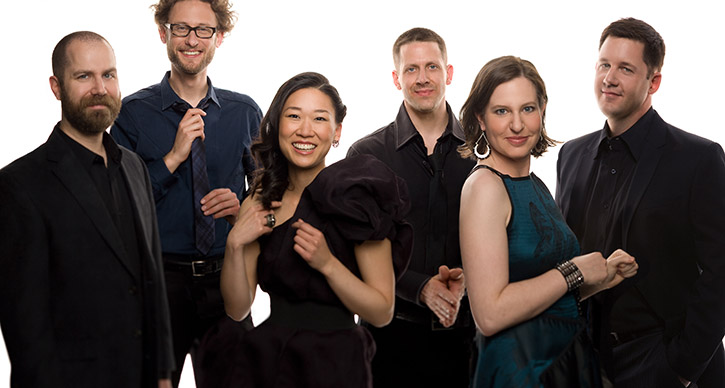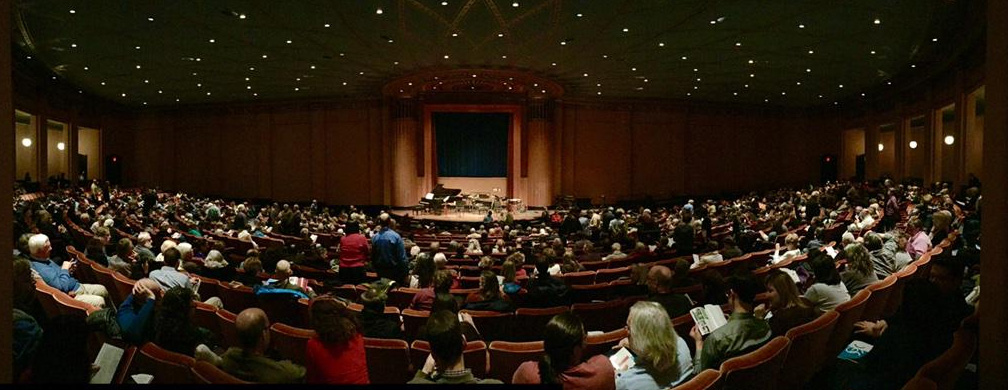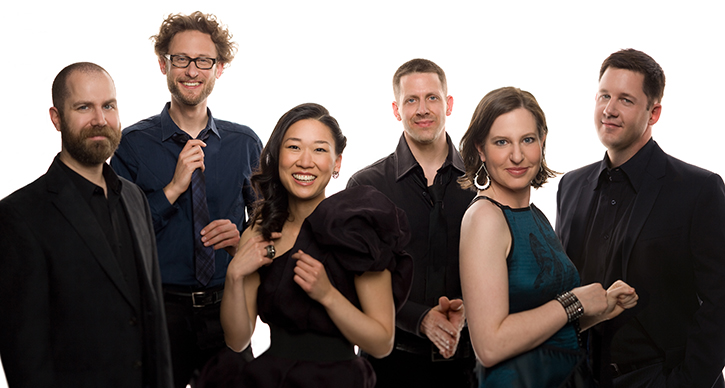Performance Livestream: Steve Reich @ 80
Steve Reich, whom the New Yorker called “the most original musical thinker of our time,” celebrates his 80th birthday in 2016; the year also marks the 40th anniversary of the premiere of Music for 18 Musicians, considered by many to be his greatest composition. On Saturday, March 18, 2017, two of Chicago’s world-class ensembles, Eighth Blackbird and Third Coast Percussion, team up to perform this seminal piece. Reich’s Sextet rounds out the program.
UMS will livestream the performance from Ann Arbor’s Hill Auditorium on Saturday, March 18, 2017 at 8 pm EST. Register to receive reminders and information about the stream:
Archived stream from the performance on Saturday, March 18, 2017:
Read the concert program book [pdf]
You can also sign up for email updates about future streams (choose “Arts & Culture Adventures” list).
Questions? Ask them in the comments below.
Chamber Music on the Rise
 Classical
Classical
The chamber group eighth blackbird performs with the percussion group Third Coast Percussion on March 18, 2017.
Music in the 21st Century is evolving. Performers are trying to find new ways to engage and excite audiences. From collaborating with visual artists to performing from memory, musicians are working to distinguish themselves in a competitive field. Orchestral and symphonic music have always been at the forefront of classical music, but chamber music has recently been gaining a lot of popularity among concert-goers.
As a music student at the University of Michigan, I’ve crossed paths with many rising stars as well as artists who have “made it” in the music community. So, I’ve had a few conversations in and out of school about how classical music is evolving and the attendant positive and negative changes.
Why chamber music has momentum
Programming
From a programmatic standpoint, small ensembles can play a wider variety of shorter pieces that cater to more musical tastes, while a large-scale symphony might have 1 to 3 pieces on the entire hour-and-a-half long program and appeal to only one musical genre.
In my opinion, attending a symphony orchestra concert can be very difficult for families and people who might not regularly listen to classical music. When I was younger, I remember squirming around, making a ruckus, and being unruly for long symphony concerts, but I think chamber ensembles can be more accessible to a wider range of people.
Repertoire
Chamber groups can choose to play transcriptions of famous works, that range from the medieval era to post-tonal melodramas such as Pierrot Lunaire, a piece so influential that it has shaped the concept of how we listen to and perceive chamber ensemble today.
Many chamber ensembles choose to include a dramatic or comedic aspect into their programs, which draws audience members in and allows them to listen to classical music in new ways.
https://www.youtube.com/watch?v=m_QRd8SjKKM
Above is the renowned Mnozil Brass ensemble performing “Lonely Boy,” with an added dramatic element.
Newer chamber ensemble configurations don’t always have a list of standard repertoire; these groups can often hit roadblocks when working to progress as an ensemble. And one of the greatest resources new ensembles have right now is the multitude of living composers who want to help define the standard repertoire, an effect which is also beneficial for the progression of classical music. As much as I love going to see the Chicago Symphony Orchestra perform standard repertoire at the highest level, I also get just as excited to see a group such as the Kronos Quartet perform a program of new works by up-and-coming composers I didn’t even know existed.
Expenses
From a financial view, a chamber ensemble can be comprised from two to a handful performers, and funding a group of this size is easier. Fewer people are employed by the ensemble, so ticket prices don’t have to be as high to generate a successful performance. Chamber ensembles can also perform in smaller and more intimate venues.
Chamber groups aren’t necessarily bound to performing in a “stuffy” symphony hall. As fun as it may be to dress up for the occasion and spend time in a beautiful space, sometimes I just want to hear good music in a more casual and less expensive setting. Chamber group instrumentation is also not set in stone, Options for sound concept, tone color, and blend are unlimited; it really just depends on what the ensemble is trying to achieve.
Chamber music is paving the new path for classical music
One of the most sought after chamber groups in the world, eighth blackbird, is setting the bar for how chamber music can and should be performed. The four-time Grammy Award winning ensemble puts on an array of exciting and diverse programs that attract audience members of all varieties.
eighth blackbird was founded when the original members were still in school at the Oberlin Conservatory and consists of six members and on the following instruments: violin/viola, cello, piano, percussion, clarinets, and flutes, which is the same instrumentation of the Pierrot Lunaire configuration. The ensemble can achieve a wide range of tone colors and sounds and is constantly commissioning and performing new works. The ensemble interacts with the audience and provides information about the works they perform to make the concerts more accessible to people who may not be well versed in classical or contemporary music. eighth blackbird’s visit during the 2016-17 season will be the group’s third performance with UMS.

eighth blackbird. Photo courtesy of the artist.
For this concert, eighth blackbird is teaming up with Third Coast Percussion, an exciting Chicago based percussion ensemble, to perform the instrumental work Music for 18 Musicians (1976) by Steve Reich. If you have never heard the music of Steve Reich, then prepare to have your mind blown. Reich incorporates a minimalist technique in his compositional style, where notes are repeated in an ostinato-like style and the harmonies move very glacially, but you become immersed in the ocean of sound and get swept away. Here is an example of a similar work by Reich: Double Sextet, a Pulitzer Prize winning piece which was commissioned by eighth blackbird.
Performing minimalist music can be mentally and physically straining because it is very repetitive and changes only slightly over time, which can catch the performers off-guard. There are also very few playing breaks in this type of music. The compositions of Steve Reich are very exciting and this all-star group of performers makes for a concert you do not want to miss.
As a musician, I think chamber music has a bright future. There are more and more opportunities arising for chamber groups: including local and national chamber concert series, chamber music competitions for all level players, as well as collegiate degrees that are offered in chamber music at schools as prestigious as the University of Michigan. I think that many musicians are evolving and revolutionizing their playing and how they connect with audiences that are constantly changing. This is a very exciting time for chamber music and I’m happy that I get to tag along for the ride.
Hear Music for 18 Musicians at the Steve Reich @ 80 concert with eighth blackbird and Third Coast Percussion.
eighth blackbird audience
An excited crowd waits for the eighth blackbird performance! Did you attend? Don’t forget to share your thoughts.
eighth blackbird performs on Saturday, January 17th
Check out our video trailer of eighth blackbird’s upcoming performance Saturday, January 17th at 8 pm here.
UMS Playlist: Evolution of Chamber Music
This post is a part of a series of playlists curated by UMS staff, artists, and community. Check out more music here.

eigth blackbird. Photo by Luke Ratray.
The Chicago-based chamber ensemble eighth blackbird performs in Ann Arbor on January 17. eighth blackbird is on the new frontier of contemporary music. As Los Angeles Times explains, “the blackbirds are examples of a new breed of super-musicians. They perform the bulk of their new music from memory. They have no need for a conductor, no matter how complex the rhythms or balances… [They are] stage animals, often in motion, enacting their scores as they play them.”
How did chamber music, which originated in the Middle Ages, evolve into the music of the blackbirds? Explore the history with our listening guide:
1. Chamber music originated during the Middle Ages as a form of entertainment for guests in palace chambers. “Mille Regretz” by Josquin des Prez (1450-1521) is an example of the style and structure of sacred music translated to a secular song that describes the pain of a lost love. The earliest chamber music often also included lutes, recorders, and early versions of the violin, viola, and cello.
2. The string quartet, one of the most common chamber ensembles, developed into its current form in the early 17th century. Since then, composers from Haydn to Beethoven to Shostakovich have revered the string quartet’s form because of the challenge of writing four unique parts that constantly change and interact with one another. The string quartet includes two violins, viola, and cello. In this track, listen for Beethoven’s mastery of “counterpoint,” the relationships between the voices.
3. Chamber music in the 20th century brought together new instrument groupings. The brass (featuring two trumpets, trombone, French horn, trombone, and tuba) rose in popularity in the 1940s. Victor Ewald is widely considered to the first composer of brass quintet music.
4. Chamber music concepts extend across genre; though “chamber music” is primarily used to describe classical music, the John Coltrane Quartet exemplifies excellent chamber music playing.
5. eighth blackbird illustrates the vast range of 21st century chamber ensembles. On this track, the group performs Steve Reich’s minimalist composition “Fast: 8:39.”
6. eighth blackbird showcases its virtuosic ensemble connectivity with Thomas Adés’ rhythmically complex “Catch.”
7. eighth blackbird collaborates with electronic music composer Dennis Desantis on the track “strange imaginary remix.”
What did you think about this playlist? Share your thoughts or song suggestions in the comments below.
Artist Interview: Flutist Tim Munro, eighth blackbird
Eighth blackbird. Photo By Luke Ratray.
The Chicago-based ensemble eighth blackbird combines the finesse of a string quartet, the energy of a rock band, and the audacity of a storefront theater company in a dazzling performance coming to Ann Arbor’s Rackham Auditorium Saturday, January 17, 2015.
Composer and UMS Lobby contributor Garrett Schumann chatted with eighth blackbird flutist Tim Munro about the group’s unique instrumentation, theatrical flair, and magical moments onstage.
Garrett Schumann: What is eighth blackbird?
Tim Munro: Well, eighth blackbird is a chamber music ensemble specializing in music by living composers. One week we might play music that’s influenced by indie rock, the next music influenced by Balinese Gamelan, the next by an abstract piece of modern visual art.
We often memorize the music that we play, which allows us to take away stands and to have a greater intensity of communication on stage and with the audience. Sometimes that means we actually move around the stage to make manifest some of the relationships that are already inherent in the music. So a lot of the time we are trying to make this new composed music more immediately vibrant and engaging for audiences.
GS: Terrific. When you created the group in 1996 there had been ensembles with the same instrumentation as eighth blackbird for a few decades. How consciously did you guys see yourselves as emerging from that kind of ensemble tradition?
TM: To speak about the instrumentation first, eighth blackbird was sort of a put-together group. At the Oberlin conservatory, this conductor, Jim Weiss, put the group together to play more challenging repertoire, stuff that isn’t normally covered in the run of conservatory conductor. And this instrumentation seemed like the perfect kaleidoscope in everything. You have strings, you have winds, you have piano, you have percussion. You’re able to sound like you’re a string quartet, you’re able to sound like you’re a piano trio, you’re able to sound like a percussion ensemble, you’re able to sound like a full orchestra and there is just every combination possible in this instrumentation. This, I think, is why in the 20th century, it really exploded.
I think the biggest influence on eighth blackbird is an ensemble with a different instrumentation, which is the Kronos Quartet. It plays a hugely diverse range of material. Everything from the wildest, most experimental modernism to the kind of obvious, fun-loving minimalist to collaborations with popular artists and world music– and doing it in a way that made it visually engaging to audiences, but was casual enough that people could feel relaxed. So I think that was the biggest influence on eighth blackbird in its earliest stages.
GS: How do you come with this diversity of programming? What do you think it is about eighth blackbird that does that diversity so well?
TM: I think that’s something that we try very hard to represent in our programs not just because we want to check all the boxes, but because we want people to never feel bored, but to always have people engaged in a concert. The diversity of the programming just reflects the diversity of different proclivities within the ensemble. Each performer in eighth blackbird is part of the artistic direction of the collective. We are all music directors of eighth blackbird and we are all coming from very different places. We all have different music that we love and I think our programs are reflective of the enthusiasm of the group all together.
What unites all of the music that we play is something in it that is unique: a color that we haven’t heard, a particular approach to constructing a piece that we haven’t done before, a spark that inspires the piece that we haven’t encountered before… something that we can then play with theatrically. So each piece on the program in some way captures something that is unique even if they are in totally different worlds. Everything on the program gives us a little something atypical or strange.
GS: Composer and Northwestern professor Lee Hyla passed away suddenly in June 2014. What was your group’s relationship with Lee Hyla and his piece “Wave”?
TM: Well, it was such a shock for everyone in the ensemble and for the whole music community in Chicago because he was such a huge presence. He’s an original. His music has a rawness and an unvarnished-ness that feels so appropriate and typical of someone of that sort of American maverick tradition. Every member of the group has a particular fondness for one of Lee’s pieces and we all loved his music. We don’t know him well personally, I don’t think anyone in the group knew him terribly well, but we are all such huge fans and were all so excited to be able to commission the piece.
I can tell you that already in rehearsing this we’ve discussed how the piece is put together. It’s a lot of fragments, it’s a piece that’s shards of things. Beautiful, pummeling, fractal, little elements that are all in shards, sort of constructed. And when we come to the moment of rehearsal where we don’t quite know our way forward, that’s often when we will talk directly with the composer. And so whenever that happens, we have that voice in the room, but we won’t be able to do that. So I’m not sure how it will affect our performance. It’s too soon for us to say.
Maybe because this is the only piece of his that we’ll ever be performing posthumously, there may be something different about the way that we and future groups approach it. It’s a piece that’s actually in its kaleidoscopic-ness begins with this vast, incredibly slow, incredibly astute music, and the last voice is the cello who has this upward gesture that almost feels like a question mark. I don’t know if one should put any emphasis on that, but for us, this performance asks us to think about those things.
Interested in learning more? Check out other interviews by Garrett Schumann.




